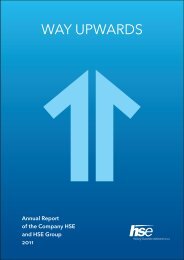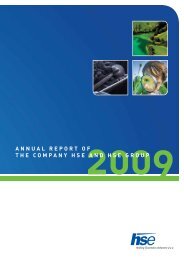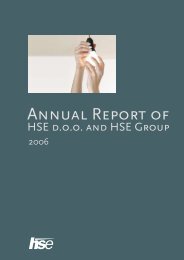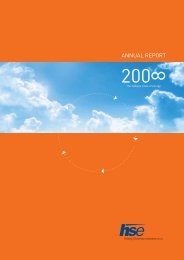Annual report - HSE
Annual report - HSE
Annual report - HSE
Create successful ePaper yourself
Turn your PDF publications into a flip-book with our unique Google optimized e-Paper software.
In 2012, risks were managed with the following activities and methods:<br />
• daily recording of measurements (actual take-over or production), monitoring of<br />
deviations of actual schedules from the planned, i.e. contractual, quantities, which<br />
provides for daily monitoring of realised deliveries and subsequent analysis, by partner,<br />
of the risk of non-delivery or failure to take over;<br />
• daily analysis of scenarios involving different hydrology conditions or failure of TPP<br />
generation units (stress testing);<br />
• daily monitoring of market conditions (prices of energy products and transmission<br />
capacities), position of the company, and VaR and MtM by individual groups of<br />
transactions with similar purpose;<br />
Quantity risk associated with changes in NTC (cross-border<br />
transmission capacities)<br />
Quantity risk associated with changes in cross-border transfer capacities arises from<br />
changes in permeability of major individual transport routes (e.g. reduction of daily crossborder<br />
transfer capacities due to wild currents). As a consequence, situations can arise<br />
where obligations from long-term contracts are not fulfilled, leading to a need to purchase<br />
more expensive energy as replacement from other sources (countries) and possibility of<br />
deviations in balances.<br />
In 2012, risks were managed with the following activities and methods:<br />
• monthly monitoring of legislation (regulations) by country and the balance of transmission<br />
capacities;<br />
• monthly scenario analysis of market conditions given the previous probabilities of events<br />
and subsequently with regard to findings on limitations to trading quantities between<br />
countries;<br />
• daily monitoring of the market position at Group- and company-level by country and by<br />
individual groups of transactions with similar purpose or significance, and monitoring of<br />
published annual, monthly and daily values of cross-border transmission capacities on<br />
individual borders.<br />
Regulatory risk<br />
Regulatory risks arise from changes in market rules or legislation in the Slovene and<br />
foreign electricity and CO 2<br />
emission coupon markets and affect the business results of<br />
the company. Their management is the most demanding as it is difficult to identify and<br />
quantify them and mitigate their effects.<br />
In 2012, the company <strong>HSE</strong> managed these risks with the following activities and methods:<br />
• constant monitoring of development of the Slovenian and foreign markets for electricity<br />
and other energy products and the CO 2<br />
emission coupons market as well as the associated<br />
regulatory framework, and response to such changes by adapting the trading strategy;<br />
• performance of long- and medium-term scenario analyses in light of the expected<br />
changes to the regulatory framework;<br />
• continuous <strong>report</strong>ing and informing about legislative changes in domestic and local<br />
markets by the domestic and local legal departments of the company;<br />
• daily monitoring of investment decisions in the EU energy sector and economic policy,<br />
and adaptation of market measures.<br />
Methodology risk<br />
Methodology risk is a risk arising from changes in actual value of individual groups of<br />
transactions due to inappropriate methodology, incorrect modelling items, errors in<br />
modelling or incompatible models. The result is incorrect projection of price dynamics or<br />
inaccurate valuation of products in the market.<br />
<strong>Annual</strong> Report <strong>HSE</strong> 2012<br />
2 Business Report<br />
86<br />
In 2012, the company <strong>HSE</strong> managed these risks with the following activities and methods:<br />
• regular monitoring of all stages of modelling;<br />
• regular examination of changes in the value of individual groups of transactions in case<br />
of different models and consideration of other defaults;<br />
• regular recording of changes and a list of valuation models.
















